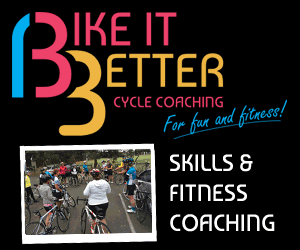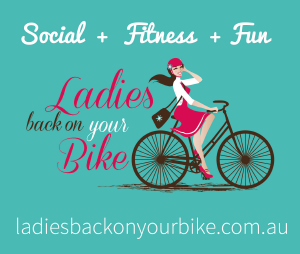A two-wheeled, high-heeled revolution is quietly brewing, writes Sondra Davoren.

Women are missing in action on Australia’s crunchy-green, asphalt bike lanes, decreed an article on The Conversation website in August last year. Like the humans in the Terminator films, we’re being over-run by lycra-clad SkyNet speed machines.
In countries such as the Netherlands, Denmark and Japan, more women than men travel by bike; whereas in Australia, women make up only about one-fifth of commuter cyclists.
Why are there fewer velopedestriennes on Australian roads? Well, the article noted reasons such as time constraints, household responsibilities and safety concerns as being the biggest hurdles to getting women on bikes. I’ve no quarrels with those conclusions (except perhaps the household responsibilities part – I would far prefer to be on my bike than vacuuming the carpet). But I confess they don’t strike me as particularly female issues. Traffic safety is always going to be a key issue for cycling and cyclists, and as for time constraints, until we finally crack teleportation, it’s going to be a factor no matter what form of transport option you elect for.
I asked (female) friends and colleagues about what they thought the barriers were to getting on a bike. One mentioned a penchant for heels and not wanting to wear flats all the time – to which I responded that I regularly wear heels on my bike, and also pointed out that anyone who says to me they can’t ride in heels has clearly never tried cleats.
Another friend noted the difference between European culture and Australian culture. In Europe life was less about work and more about play, and that in our busy high-pressured Australian lifestyles, it’s more convenient to get in the car than to expel effort trying to get about.
The gist of these comments was that high-cycling countries have a way of life which isn’t the same as here; the grass is greener on that side, and we Antipodean cyclists just don’t have it as easy. To an extent, that is true; we are accustomed to a lifestyle that lets us take our car everywhere. Our cities and businesses are designed with cars in mind. Whereas in high-cycling countries, people are more likely to use bicycles designed for everyday travel; upright bikes, with greater carrying capacity (so you can carry your children and the shopping).
More to the point, in high-cycling countries, it is normal to ride in everyday clothing rather than sports gear (including to work).
And it’s this last point that is the catchcry of Frocks on Bikes: a movement aimed at encouraging women to embrace the frock as entirely appropriate cycling attire and in doing so, to encourage people in general to leave the car at home and cycle.
Frocks on Bikes spontaneously emerged in New Zealand in December 2008 over two short weeks in the lead up to the 350 Climate Action festivals held in Auckland and Wellington. To support the festivals, the Frocks on Bikes mothership mobilised over 350 Frockers pedalling for change and embracing the bike as a fun and sustainable way to move.
The Frocks on Bikes ethos has struck a chord with women across New Zealand and Australia. In early 2010, the Melbourne chapter joined the Frock, and set about encouraging the good women of Melbourne to show their love of cycling. A Perth chapter is getting up and riding too.
Past Melbourne Frocks on Bikes events have included a garage sale crawl, a tour of the St Kilda foreshore solar system, and Frockers regularly represent at other cycling events such as the Tweed Ride. There are plans for similar events this year, as well as some workshops to address all those burning frocks-on-bikes questions (such as, how do you keep your frock from flying away?).
To be perfectly clear, Frocks on Bikes is not anti-lycra. Nor is it anti-car. It’s also not just for women (although is predominantly so).
It is about pointing out that commuter cycling is not just for the Dutch and the Danes. But when the cycling norm is lycra, cleats and a carbon-fibre bike, it can seem a little daunting to people wanting to get back on the bike (not to mention a little expensive). Sometimes, I take public transport to work. Occasionally, I walk. I’d never really think about a full wardrobe change to do either; equally, riding for commuting should be no different.
Find more info, or to start your own chapter, visit Frocks on Bikes.
Ride On content is editorially independent, but is supported financially by members of Bicycle Network. If you enjoy our articles and want to support the future publication of high-quality content, please consider helping out by becoming a member.



Nobody mentioned the ‘elephant in the room’; compulsory helmet wearing. We are the only developed country, as far as I’m aware, where helmet hair is unavoidable. In movies women on bikes are seen riding in frock and heels with hair flowing free – helmets are not added to the attractive image!
In movies women do not get hit by cars whilst stopped on their bike on the bike path (she typed whilst kissing her recently life-saving helmet). Helmet hair rocks!
There’s one other country with enforced compulsory helmet law and that’s New Zealand. Helmets are compulsory in Germany, but the law isn’t enforced because they want people to cycle.
Interesting info thanks
Skirts are really practical cycling gear, especially when you’ve got a tail wind.
But a key problem wearing civies cycling to work in Australia, is that you get showered with muddy water by ‘sporting’ cyclists who won’t use mud guards.
I agree gina the hemet issue is a much bigger deterent from cycling than heels but maybe official bicycle organisations arent allowed to mention it?